Analyzing Financial Crisis in HR Firm Using VUCA Framework
VerifiedAdded on 2022/10/10
|6
|1255
|284
Report
AI Summary
This report examines the application of the VUCA (Volatility, Uncertainty, Complexity, and Ambiguity) framework to a human resource firm facing a financial crisis. The firm is struggling due to competition from online human resource websites, leading to a decline in clients and financial instability. The analysis uses the VUCA framework to diagnose the firm's current situation, evaluating the impact of each element on decision-making and transformation strategies. It explores the volatility of the firm's finances, the uncertainty surrounding customer behavior, the complexity of restructuring, and the ambiguity of the digital environment. The report discusses how the VUCA framework can help identify risks and develop strategic plans for mitigation and recovery. The conclusion emphasizes the importance of the VUCA framework in making crucial business decisions and achieving stability in a rapidly changing environment. The report also includes references to key academic sources.
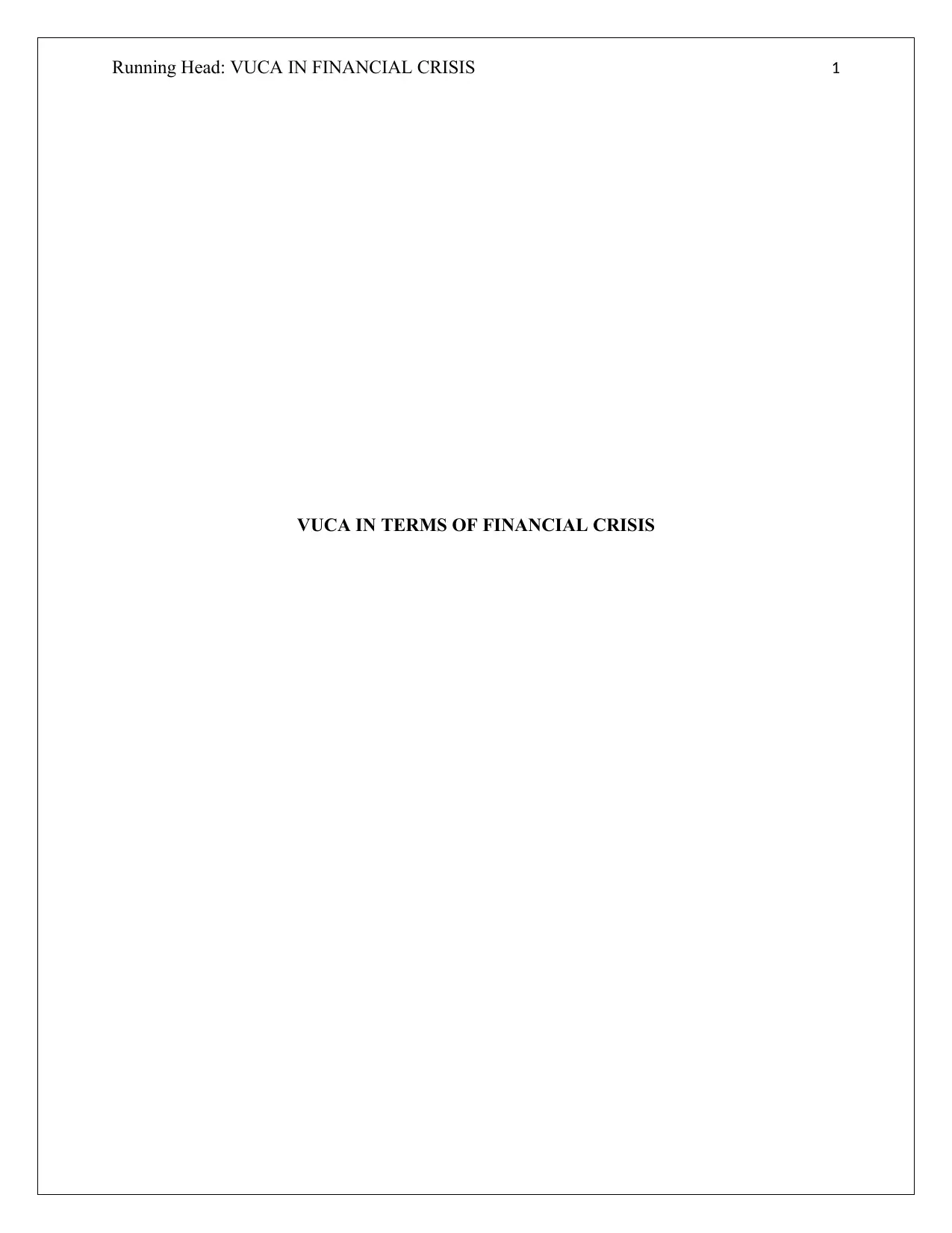
Running Head: VUCA IN FINANCIAL CRISIS 1
VUCA IN TERMS OF FINANCIAL CRISIS
VUCA IN TERMS OF FINANCIAL CRISIS
Paraphrase This Document
Need a fresh take? Get an instant paraphrase of this document with our AI Paraphraser
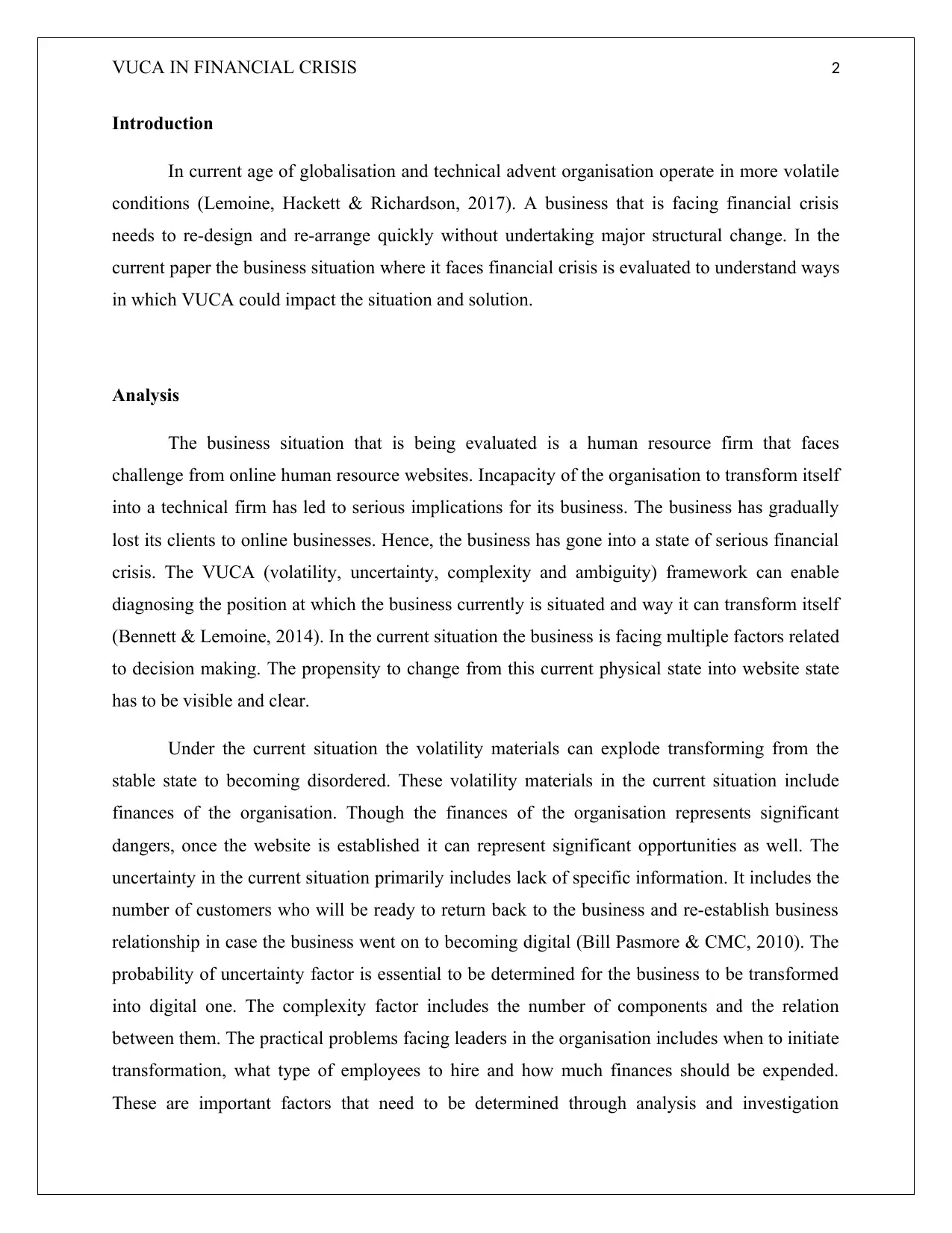
VUCA IN FINANCIAL CRISIS 2
Introduction
In current age of globalisation and technical advent organisation operate in more volatile
conditions (Lemoine, Hackett & Richardson, 2017). A business that is facing financial crisis
needs to re-design and re-arrange quickly without undertaking major structural change. In the
current paper the business situation where it faces financial crisis is evaluated to understand ways
in which VUCA could impact the situation and solution.
Analysis
The business situation that is being evaluated is a human resource firm that faces
challenge from online human resource websites. Incapacity of the organisation to transform itself
into a technical firm has led to serious implications for its business. The business has gradually
lost its clients to online businesses. Hence, the business has gone into a state of serious financial
crisis. The VUCA (volatility, uncertainty, complexity and ambiguity) framework can enable
diagnosing the position at which the business currently is situated and way it can transform itself
(Bennett & Lemoine, 2014). In the current situation the business is facing multiple factors related
to decision making. The propensity to change from this current physical state into website state
has to be visible and clear.
Under the current situation the volatility materials can explode transforming from the
stable state to becoming disordered. These volatility materials in the current situation include
finances of the organisation. Though the finances of the organisation represents significant
dangers, once the website is established it can represent significant opportunities as well. The
uncertainty in the current situation primarily includes lack of specific information. It includes the
number of customers who will be ready to return back to the business and re-establish business
relationship in case the business went on to becoming digital (Bill Pasmore & CMC, 2010). The
probability of uncertainty factor is essential to be determined for the business to be transformed
into digital one. The complexity factor includes the number of components and the relation
between them. The practical problems facing leaders in the organisation includes when to initiate
transformation, what type of employees to hire and how much finances should be expended.
These are important factors that need to be determined through analysis and investigation
Introduction
In current age of globalisation and technical advent organisation operate in more volatile
conditions (Lemoine, Hackett & Richardson, 2017). A business that is facing financial crisis
needs to re-design and re-arrange quickly without undertaking major structural change. In the
current paper the business situation where it faces financial crisis is evaluated to understand ways
in which VUCA could impact the situation and solution.
Analysis
The business situation that is being evaluated is a human resource firm that faces
challenge from online human resource websites. Incapacity of the organisation to transform itself
into a technical firm has led to serious implications for its business. The business has gradually
lost its clients to online businesses. Hence, the business has gone into a state of serious financial
crisis. The VUCA (volatility, uncertainty, complexity and ambiguity) framework can enable
diagnosing the position at which the business currently is situated and way it can transform itself
(Bennett & Lemoine, 2014). In the current situation the business is facing multiple factors related
to decision making. The propensity to change from this current physical state into website state
has to be visible and clear.
Under the current situation the volatility materials can explode transforming from the
stable state to becoming disordered. These volatility materials in the current situation include
finances of the organisation. Though the finances of the organisation represents significant
dangers, once the website is established it can represent significant opportunities as well. The
uncertainty in the current situation primarily includes lack of specific information. It includes the
number of customers who will be ready to return back to the business and re-establish business
relationship in case the business went on to becoming digital (Bill Pasmore & CMC, 2010). The
probability of uncertainty factor is essential to be determined for the business to be transformed
into digital one. The complexity factor includes the number of components and the relation
between them. The practical problems facing leaders in the organisation includes when to initiate
transformation, what type of employees to hire and how much finances should be expended.
These are important factors that need to be determined through analysis and investigation
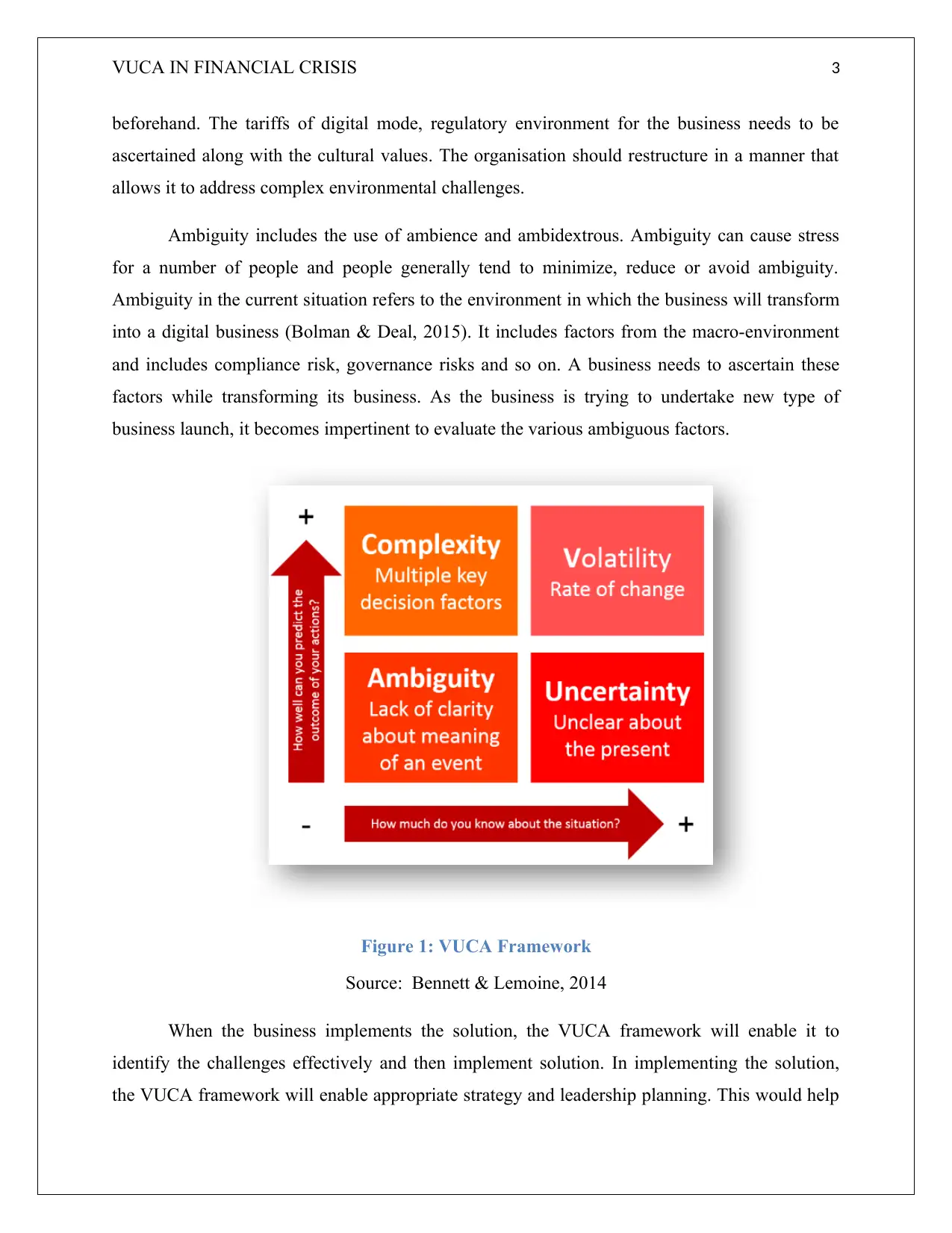
VUCA IN FINANCIAL CRISIS 3
beforehand. The tariffs of digital mode, regulatory environment for the business needs to be
ascertained along with the cultural values. The organisation should restructure in a manner that
allows it to address complex environmental challenges.
Ambiguity includes the use of ambience and ambidextrous. Ambiguity can cause stress
for a number of people and people generally tend to minimize, reduce or avoid ambiguity.
Ambiguity in the current situation refers to the environment in which the business will transform
into a digital business (Bolman & Deal, 2015). It includes factors from the macro-environment
and includes compliance risk, governance risks and so on. A business needs to ascertain these
factors while transforming its business. As the business is trying to undertake new type of
business launch, it becomes impertinent to evaluate the various ambiguous factors.
Figure 1: VUCA Framework
Source: Bennett & Lemoine, 2014
When the business implements the solution, the VUCA framework will enable it to
identify the challenges effectively and then implement solution. In implementing the solution,
the VUCA framework will enable appropriate strategy and leadership planning. This would help
beforehand. The tariffs of digital mode, regulatory environment for the business needs to be
ascertained along with the cultural values. The organisation should restructure in a manner that
allows it to address complex environmental challenges.
Ambiguity includes the use of ambience and ambidextrous. Ambiguity can cause stress
for a number of people and people generally tend to minimize, reduce or avoid ambiguity.
Ambiguity in the current situation refers to the environment in which the business will transform
into a digital business (Bolman & Deal, 2015). It includes factors from the macro-environment
and includes compliance risk, governance risks and so on. A business needs to ascertain these
factors while transforming its business. As the business is trying to undertake new type of
business launch, it becomes impertinent to evaluate the various ambiguous factors.
Figure 1: VUCA Framework
Source: Bennett & Lemoine, 2014
When the business implements the solution, the VUCA framework will enable it to
identify the challenges effectively and then implement solution. In implementing the solution,
the VUCA framework will enable appropriate strategy and leadership planning. This would help
⊘ This is a preview!⊘
Do you want full access?
Subscribe today to unlock all pages.

Trusted by 1+ million students worldwide
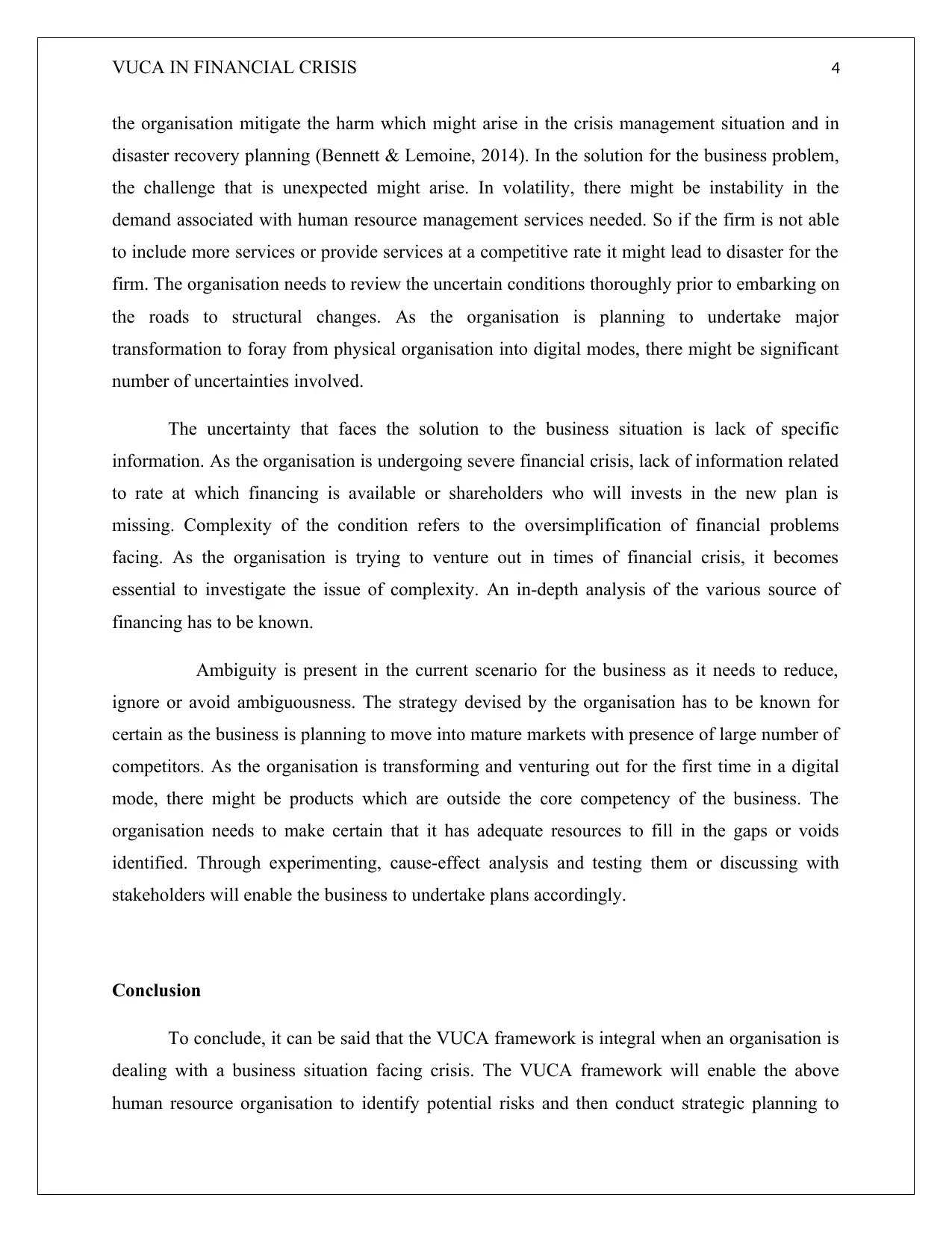
VUCA IN FINANCIAL CRISIS 4
the organisation mitigate the harm which might arise in the crisis management situation and in
disaster recovery planning (Bennett & Lemoine, 2014). In the solution for the business problem,
the challenge that is unexpected might arise. In volatility, there might be instability in the
demand associated with human resource management services needed. So if the firm is not able
to include more services or provide services at a competitive rate it might lead to disaster for the
firm. The organisation needs to review the uncertain conditions thoroughly prior to embarking on
the roads to structural changes. As the organisation is planning to undertake major
transformation to foray from physical organisation into digital modes, there might be significant
number of uncertainties involved.
The uncertainty that faces the solution to the business situation is lack of specific
information. As the organisation is undergoing severe financial crisis, lack of information related
to rate at which financing is available or shareholders who will invests in the new plan is
missing. Complexity of the condition refers to the oversimplification of financial problems
facing. As the organisation is trying to venture out in times of financial crisis, it becomes
essential to investigate the issue of complexity. An in-depth analysis of the various source of
financing has to be known.
Ambiguity is present in the current scenario for the business as it needs to reduce,
ignore or avoid ambiguousness. The strategy devised by the organisation has to be known for
certain as the business is planning to move into mature markets with presence of large number of
competitors. As the organisation is transforming and venturing out for the first time in a digital
mode, there might be products which are outside the core competency of the business. The
organisation needs to make certain that it has adequate resources to fill in the gaps or voids
identified. Through experimenting, cause-effect analysis and testing them or discussing with
stakeholders will enable the business to undertake plans accordingly.
Conclusion
To conclude, it can be said that the VUCA framework is integral when an organisation is
dealing with a business situation facing crisis. The VUCA framework will enable the above
human resource organisation to identify potential risks and then conduct strategic planning to
the organisation mitigate the harm which might arise in the crisis management situation and in
disaster recovery planning (Bennett & Lemoine, 2014). In the solution for the business problem,
the challenge that is unexpected might arise. In volatility, there might be instability in the
demand associated with human resource management services needed. So if the firm is not able
to include more services or provide services at a competitive rate it might lead to disaster for the
firm. The organisation needs to review the uncertain conditions thoroughly prior to embarking on
the roads to structural changes. As the organisation is planning to undertake major
transformation to foray from physical organisation into digital modes, there might be significant
number of uncertainties involved.
The uncertainty that faces the solution to the business situation is lack of specific
information. As the organisation is undergoing severe financial crisis, lack of information related
to rate at which financing is available or shareholders who will invests in the new plan is
missing. Complexity of the condition refers to the oversimplification of financial problems
facing. As the organisation is trying to venture out in times of financial crisis, it becomes
essential to investigate the issue of complexity. An in-depth analysis of the various source of
financing has to be known.
Ambiguity is present in the current scenario for the business as it needs to reduce,
ignore or avoid ambiguousness. The strategy devised by the organisation has to be known for
certain as the business is planning to move into mature markets with presence of large number of
competitors. As the organisation is transforming and venturing out for the first time in a digital
mode, there might be products which are outside the core competency of the business. The
organisation needs to make certain that it has adequate resources to fill in the gaps or voids
identified. Through experimenting, cause-effect analysis and testing them or discussing with
stakeholders will enable the business to undertake plans accordingly.
Conclusion
To conclude, it can be said that the VUCA framework is integral when an organisation is
dealing with a business situation facing crisis. The VUCA framework will enable the above
human resource organisation to identify potential risks and then conduct strategic planning to
Paraphrase This Document
Need a fresh take? Get an instant paraphrase of this document with our AI Paraphraser
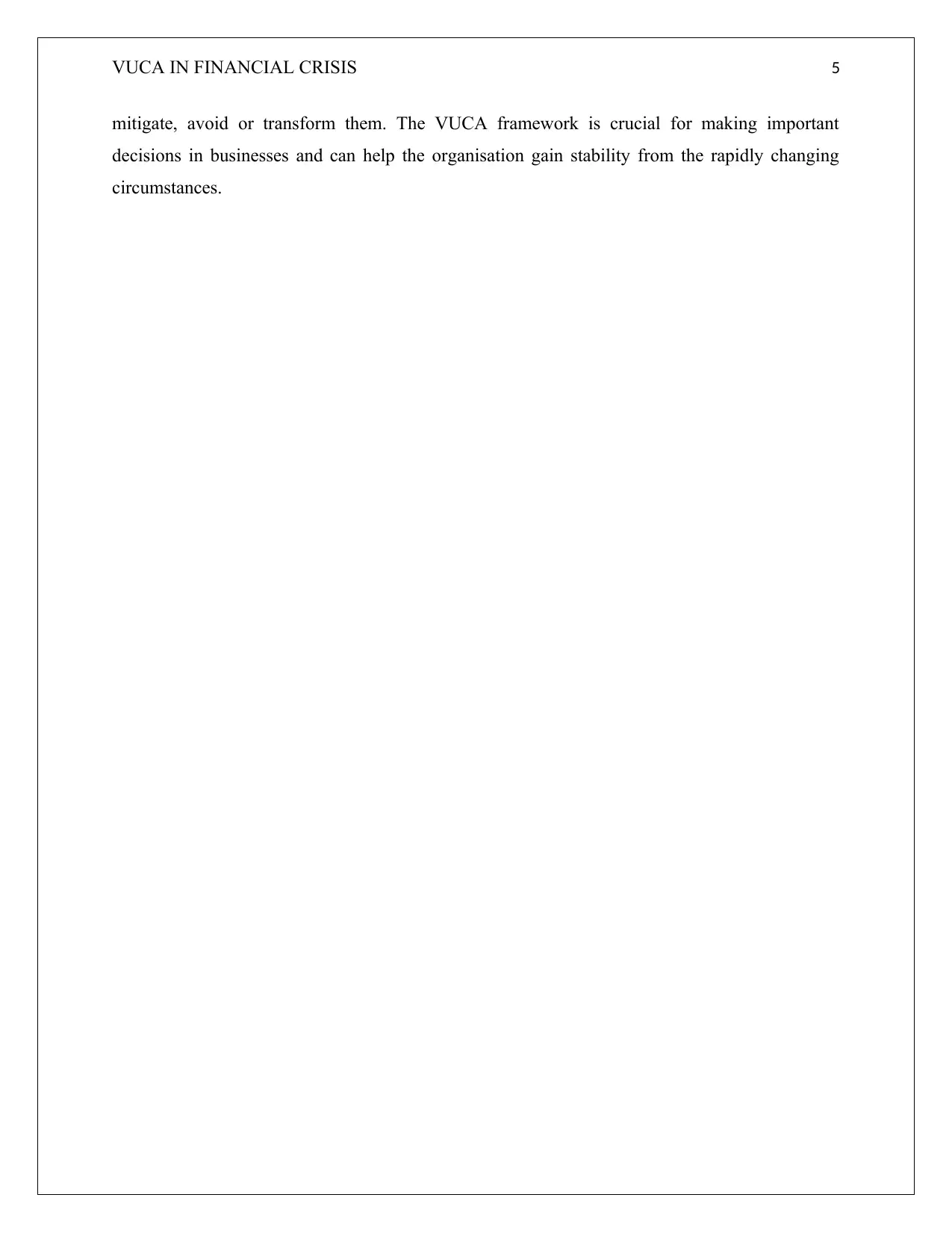
VUCA IN FINANCIAL CRISIS 5
mitigate, avoid or transform them. The VUCA framework is crucial for making important
decisions in businesses and can help the organisation gain stability from the rapidly changing
circumstances.
mitigate, avoid or transform them. The VUCA framework is crucial for making important
decisions in businesses and can help the organisation gain stability from the rapidly changing
circumstances.
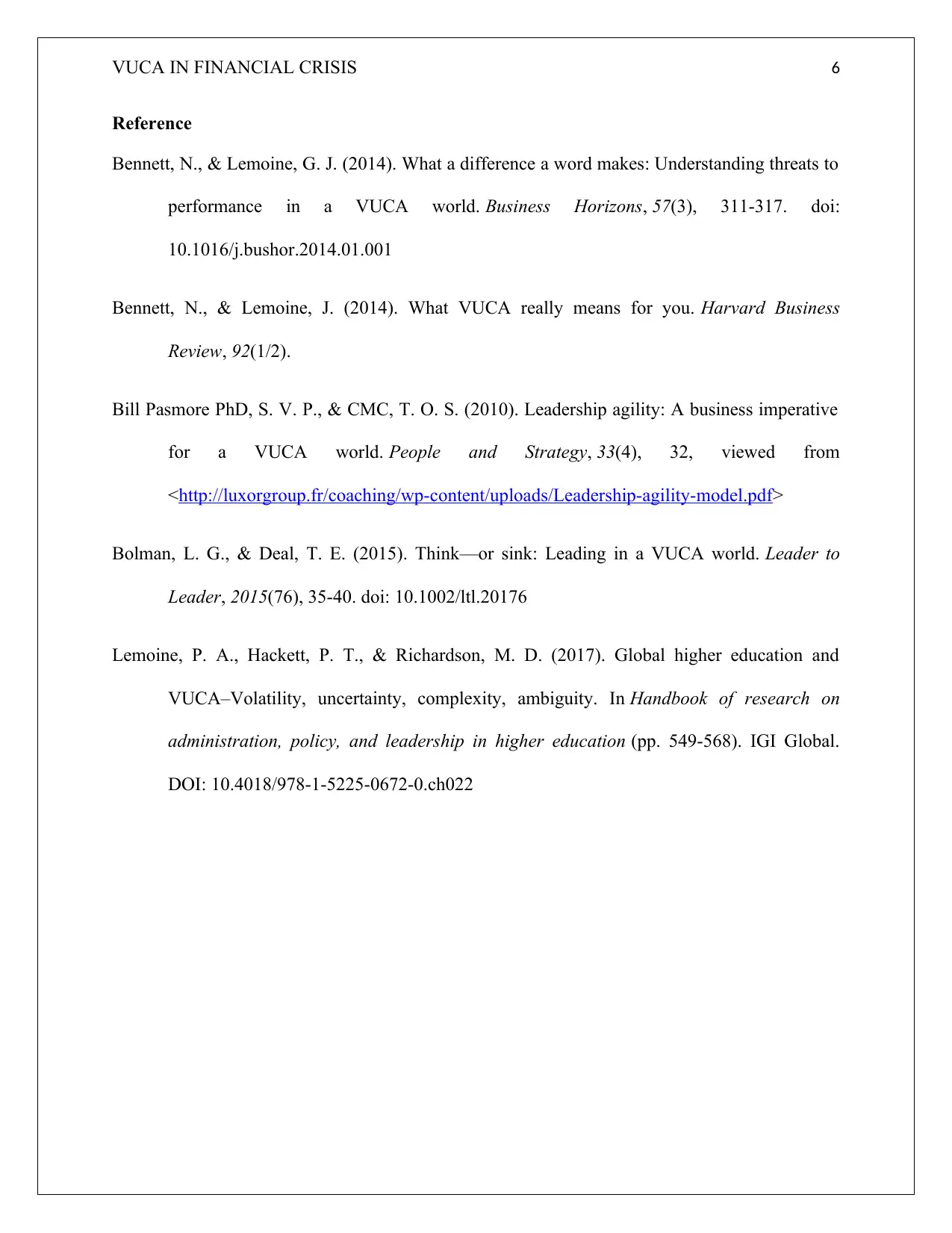
VUCA IN FINANCIAL CRISIS 6
Reference
Bennett, N., & Lemoine, G. J. (2014). What a difference a word makes: Understanding threats to
performance in a VUCA world. Business Horizons, 57(3), 311-317. doi:
10.1016/j.bushor.2014.01.001
Bennett, N., & Lemoine, J. (2014). What VUCA really means for you. Harvard Business
Review, 92(1/2).
Bill Pasmore PhD, S. V. P., & CMC, T. O. S. (2010). Leadership agility: A business imperative
for a VUCA world. People and Strategy, 33(4), 32, viewed from
<http://luxorgroup.fr/coaching/wp-content/uploads/Leadership-agility-model.pdf>
Bolman, L. G., & Deal, T. E. (2015). Think—or sink: Leading in a VUCA world. Leader to
Leader, 2015(76), 35-40. doi: 10.1002/ltl.20176
Lemoine, P. A., Hackett, P. T., & Richardson, M. D. (2017). Global higher education and
VUCA–Volatility, uncertainty, complexity, ambiguity. In Handbook of research on
administration, policy, and leadership in higher education (pp. 549-568). IGI Global.
DOI: 10.4018/978-1-5225-0672-0.ch022
Reference
Bennett, N., & Lemoine, G. J. (2014). What a difference a word makes: Understanding threats to
performance in a VUCA world. Business Horizons, 57(3), 311-317. doi:
10.1016/j.bushor.2014.01.001
Bennett, N., & Lemoine, J. (2014). What VUCA really means for you. Harvard Business
Review, 92(1/2).
Bill Pasmore PhD, S. V. P., & CMC, T. O. S. (2010). Leadership agility: A business imperative
for a VUCA world. People and Strategy, 33(4), 32, viewed from
<http://luxorgroup.fr/coaching/wp-content/uploads/Leadership-agility-model.pdf>
Bolman, L. G., & Deal, T. E. (2015). Think—or sink: Leading in a VUCA world. Leader to
Leader, 2015(76), 35-40. doi: 10.1002/ltl.20176
Lemoine, P. A., Hackett, P. T., & Richardson, M. D. (2017). Global higher education and
VUCA–Volatility, uncertainty, complexity, ambiguity. In Handbook of research on
administration, policy, and leadership in higher education (pp. 549-568). IGI Global.
DOI: 10.4018/978-1-5225-0672-0.ch022
⊘ This is a preview!⊘
Do you want full access?
Subscribe today to unlock all pages.

Trusted by 1+ million students worldwide
1 out of 6
Related Documents
Your All-in-One AI-Powered Toolkit for Academic Success.
+13062052269
info@desklib.com
Available 24*7 on WhatsApp / Email
![[object Object]](/_next/static/media/star-bottom.7253800d.svg)
Unlock your academic potential
Copyright © 2020–2025 A2Z Services. All Rights Reserved. Developed and managed by ZUCOL.



